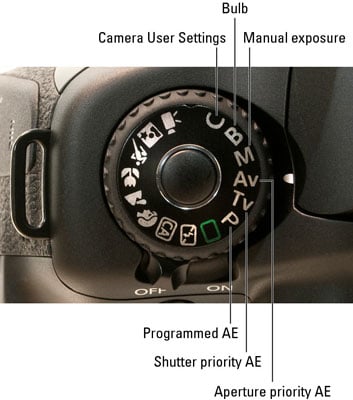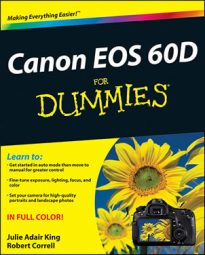With your Canon EOS 60D in Creative Auto mode, you can affect picture brightness and depth of field to some extent by using the Exposure and Background sliders. However, you don’t have full control over either aspect of your images, and you have no access to certain camera options that can help you solve tough exposure problems.
The moral of this story is that if you want to take full advantage of your camera’s exposure tools, set the Mode dial to one of its six creative exposure modes: P, Tv, Av, M, B, or C. To fully control exposure and other picture properties, choose one of these exposure modes.

Each mode offers a different level of control over two critical exposure settings: aperture and shutter speed. Here’s a quick introduction:
-
P (programmed autoexposure): The camera selects both the aperture and shutter speed for you, but you can choose from different combinations of the two.
-
Tv (shutter priority autoexposure): You select a shutter speed, and the camera chooses the aperture setting that produces a good exposure.
Why Tv? Well, shutter speed controls exposure time; Tv stands for time value.
-
Av (aperture priority autoexposure): The opposite of shutter-priority autoexposure, you select the aperture setting: thus Av, for aperture value. The camera then selects the appropriate shutter speed to properly expose the picture.
-
M (manual exposure): Specify both shutter speed and aperture (and ISO, if you like). And even in M mode, the camera assists you by displaying a meter that tells you whether your exposure settings are on target.
-
B (Bulb): Bulb mode is a special shutter speed mode, where you open the shutter normally to start taking the photo. The catch is that you keep the shutter open for as long as you hold down the shutter button. Bulb mode is great for night photography, catching lightning in action, and photographing thunderstorms or starry skies.
Because the length of the exposure is entirely up to you, the camera provides no exposure information. You set the ISO and aperture based on other criteria and keep the shutter open as required.
-
C (Camera User Settings): Camera User Settings is another special mode. You can register (save) most camera settings (including shooting mode, menu options, and so forth) and instantly recall them by selecting C from Mode Dial mode.
In the context of exposure, this mode behaves exactly like the mode you selected when you registered the settings. In C mode, you see the actual exposure mode on the back of the camera in the Shooting Settings display.

